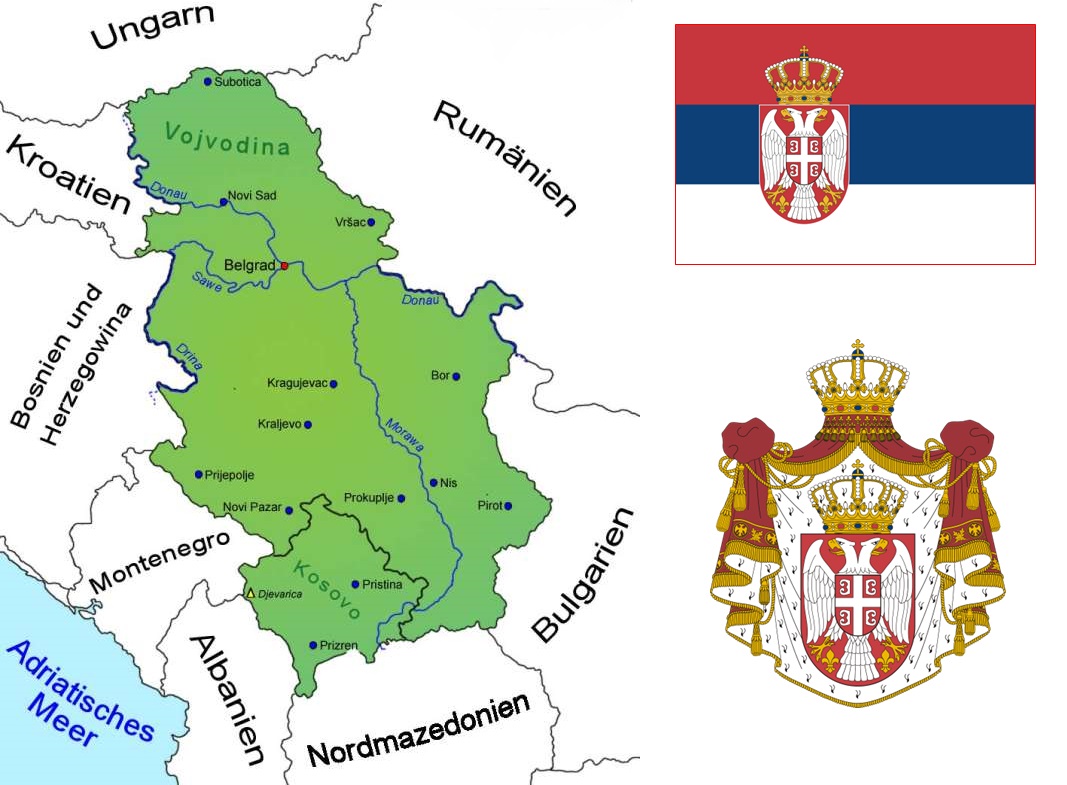Results
2,284 Results
Loading more Results ...
Loading more Results ...
Wine regions in Serbia 9 growing regions
Description to Serbia
The Republic of Serbia in Central and South-Eastern Europe with its capital Belgrade covers 88,361 km². It borders Hungary to the north, Romania and Bulgaria to the east, North Macedonia and Albania to the south, Montenegro to the south-west and Bosnia-Herzegovina and Croatia to the west. From the 1990s onwards, the former state of Yugoslavia disintegrated as a result of warlike events. First Bosnia-Herzegovina, Croatia, North Macedonia and Slovenia became independent and in 2003 the rest was renamed Serbia-Montenegro and in 2006 Montenegro seceded and became Serbia. Finally, in 2008, the southern province of Kosovo also proclaimed itself independent.

History
Viticulture in Serbia dates back to ancient times and was already influenced by the Thracians and Greeks before the turn of the millennium. After Emperor Domitian (51-96) banned viticulture outside the Apennines in the Roman provinces in 92 AD, it was reintroduced by Emperor Probus (232-282). The first vines were probably planted on the slopes of Fruška Gora in Syrmia (in Vojvodina), as indicated by some archaeological finds. Among other things, a mosaic of the vine-covered wine god Dionysus was found there in the Romuliana palace complex of Emperor Galerius (250-311) near Zaječar in eastern Serbia, which was built as a retirement home. Between the 12th and 14th centuries, Serbian Orthodox monasteries gave rise to a flourishing wine culture, which subsequently gained great economic importance. In 1459, Serbia was finally conquered by the Ottomans and remained part of the Ottoman Empire until 1804. During this time, the Islamic ban on alcohol led to a decline in viticulture.
Viticulture in the modern era
There was an upswing after the Second World War (1939-1945) during the communist era under Josip Broz Tito (1892-1980) in what was then Yugoslavia. The total area at that time was 250,000 hectares. Mainly simple mass wines were produced. This included the medium sweet developed blackbird field (today Kosovo). At the time, Serbia was the largest and most important wine country in Yugoslavia. Due to the collapse, the wine-growing structure changed considerably. There were hardly any warlike events in central Serbia, which is why the vineyards remained largely unscathed, unlike in other parts of the country.
Wine-growing areas
These are mainly located along the Danube, Morava and Timok rivers, close to the borders with Romania and Bulgaria. Serbia is divided into five wine-growing regions. These are Timok in the Krajina with Negotin and Knjaževac on the Romanian border (mainly red wine), Sumadija-Velika Morava south of Belgrade (mainly white wine), Zapadna-Morava on the upper reaches of the River Morava, Juzna-Morava with Vranje in the south (the best quality red wines) and Pocerina-Podgora east of Belgrade. The continental climate is characterised by cold winters and warm to hot summers.
Grape variety index
In 2022, the vineyards covered 20,113 hectares and the wine production volume was 472,000 hectolitres. Traditionally, fruit brandies, especially plum, are very popular, The grape variety index:
Grape variety |
Colour |
Synonyms or Serbian name |
Hectare |
| Cabernet Sauvignon | red | - | 2.111 |
| Welschriesling | white | Graševina | 2.037 |
| Merlot | red | - | 1.968 |
| Chardonnay | white | - | 1.455 |
| Riesling | white | - | 1.361 |
| Prokupac | red | Nikodimka, Nisevka, Rskavac | 916 |
| Sauvignon Blanc | white | - | 741 |
| Blaufränkisch | red | - | 727 |
| Pinot Noir | red | - | 633 |
| Muscat d'Hamburg | red | Muscat Hamburg Crni | 624 |
| Župlyanka | white | Sura Lisicina | 255 |
| Dimyat | white | Smederevka | 192 |
| Muscat Ottonel | white | - | 183 |
| Gewürztraminer / Traminer | white | Traminac Crveni | 142 |
| Muscat Fleur d'Oranger | white | - | 116 |
| Pinot Gris | white | - | 112 |
| Marselan | red | - | 84 |
| Cabernet Franc | red | - | 79 |
| Afus Ali | white | - | 73 |
| Pamid | red | - | 67 |
| Rkatsiteli | white | - | 60 |
| Victoria | white | - | 55 |
| Gamay | red | Gamay Noir | 54 |
| Morava | white | - | 34 |
| Muscat Blanc | white | Tamjanika | 31 |
| Kadarka | red | Skadarka | 15 |
| Muscat Dr Hogg | white | Muscat | 14 |
| Vranac | red | Vranac Crmnichki | 3 |
| Cardinal | red | - | 3 |
| Panonia | white | - | 2 |
| Cosmopolita | white | - | 1 |
| Krstač | white | Bijeli Krstač | ? |
| Začinak | red | Krajinsko Crno, Negotinsko Crno | ? |
| Žilavka | white | Mostarska Žilavka | ? |
Map: Goruma
Flag: from srbija.gov.rs, Public domain, Link
Coat of arms: Public domain, Link
Source 1st paragraph: WIKIPEDIA Serbia
Classified wine producers in Serbia 2
Recent wines 29
 Erdevik Winery
— Srem / Fruška Gora
2021 "Roza Nostrica"
13.90 €
Erdevik Winery
— Srem / Fruška Gora
2021 "Roza Nostrica"
13.90 €

 Vinarija Deurić
— Srem / Fruška Gora
2017 "Aksiom"
19.50 €
Vinarija Deurić
— Srem / Fruška Gora
2017 "Aksiom"
19.50 €

 Vinarija Deurić
— Srem / Fruška Gora
2017 Chardonnay
19.50 €
Vinarija Deurić
— Srem / Fruška Gora
2017 Chardonnay
19.50 €

